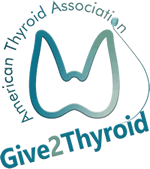ABBREVIATIONS & DEFINITIONS
Thyroid nodule: an abnormal growth of thyroid cells that forms a lump within the thyroid. While most thyroid nodules are non-cancerous (Benign), ~5% are cancerous.
Thyroid Ultrasound: a common imaging test used to evaluate the structure of the thyroid gland. Ultrasound uses soundwaves to create a picture of the structure of the thyroid gland and accurately identify and characterize nodules within the thyroid. Ultrasound is also frequently used to guide the needle into a nodule during a thyroid nodule biopsy.
Thyroid biopsy: a simple procedure that is done in the doctor’s office to determine if a thyroid nodule is benign (non-cancerous) or cancer. The doctor uses a very thin needle to withdraw cells from the thyroid nodule. Patients usually return home or to work after the biopsy without any ill effects.
Indeterminate thyroid biopsy: this happens a few atypical cells are seen but not enough to be abnormal (atypia of unknown significance (AUS) or follicular lesion of unknown significance (FLUS)) or when the diagnosis is a follicular or hurthle cell lesion. Follicular and hurthle cells are normal cells found in the thyroid. Current analysis of thyroid biopsy results cannot differentiate between follicular or hurthle cell cancer from noncancerous adenomas. This occurs in 15-20% of biopsies and often results in the need for surgery to remove the nodule.
Mutation: A permanent change in one of the genes.
Genes: a molecular unit of heredity of a living organism. Living beings depend on genes, as they code for all proteins and RNA chains that have functions in a cell. Genes hold the information to build and maintain an organism’s cells and pass genetic traits to offspring.
Papillary thyroid cancer: the most common type of thyroid cancer.
Molecular markers: genes and microRNAs that are expressed in benign or cancerous cells. Molecular markers can be used in thyroid biopsy specimens to either to diagnose cancer or to determine that the nodule is benign. The two most common molecular marker tests are the AfirmaTM Gene Expression Classifier and ThyroseqTM
Cancer-associated genes: these are genes that are normally expressed in cells. Cancer cells frequently have mutations in these genes. It is unclear whether mutations in these genes cause the cancer or are just associated with the cancer cells. The cancer-associated genes important in thyroid cancer are BRAF, RET/PTC, TERT and RAS.



